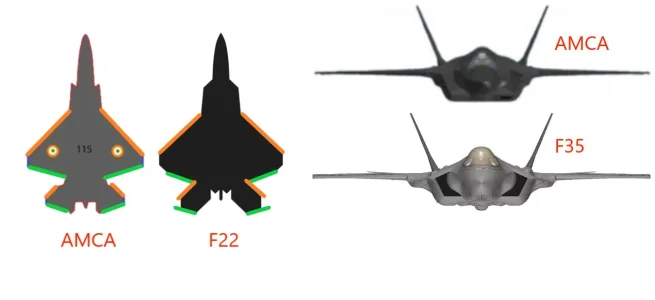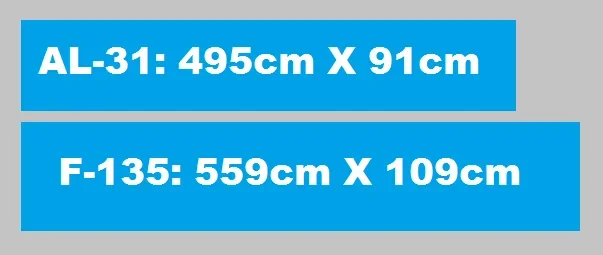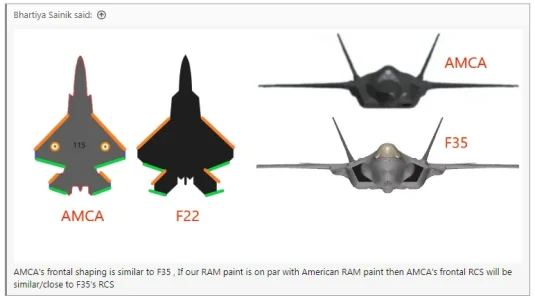- Joined
- Jul 2, 2024
- Messages
- 930
- Likes
- 2,435
CAUTION/DISCLAIMER:
- This thread is inspired by global tech evolution, R&D & big jets like Su-3X including Naval variant Su-33.
- On casual forum, there is no need to wait for official govt. or DoD statements.
- Neither global tech evolution waits for lagging countries, nor Discussions for every component to mature & be available.
>Some day upgraded Super-Su-30MKI will need replacement by similar size & weight jet due to technological advancement, requirement of 5th-6th gen. Even after Super-Sukhoi upgrade which is analogous to Su-35-S, the RCS & IRS will be quite high.
>The radars, SAMs, AAMs have improved a lot. The latest ones are made aiming 5th gen jets.
>The frontline jets have to be latest gen/tech to act like spies & snipers, which can be supplemented by previous gen jets following behind.
>When the engine &/or airframe design are inadequate, a new airframe & new/modified components are required then a gen leap occurs, who's R&D takes time in decades, hence EU dumped 5th gen & moved to 6th gen FCAS & GCAP to catch up with USA. That's the answer to how can we make 6gen w/o 5gen.
>Hence AMCA & similar jets also may not have adequate thrust, volume for payload, fuel & advanced equipments, range/endurance. Otherwise AMCA in stealth config w/o any CCMs should be expected to use 4 BVR-AAMs with 100% Pk & then kill any adversary with gun.
>Bharat's attempt to make AMCA is sluggish like LCA, bcoz we couldn't get good engines, or even average engines, by self/import/JV to experiment with prototypes, but we are fine with using average engines on active duty jets.
>Bharat exited PAKFA/FGFA project with Russia due to lack of ToT of Su-57. Now there are speculations to get some as stopgap measure.
>China has good numbers of J-20, will have more of it, & will have derivatives of J-31/35.
>S.Korea producing KF-21 Boramae has population of 51.7 million & around 100,000 sqKm. KF-21 will most likely improve like X-35 became F-35.
>Sweden with area 450,000+ sqKm has population 10.6 million with history of making good jets. They were studying on their 5gen Flygsystem 2020. Later there were talks to join GCAP or FCAS. They may announce some surprise any day.
>Turkey with area 783,000+ sqKm & population 86.2 million had its 1st flight of Kaan.
>Kaan & J-31 can be offered to Pakistan.
>Pakistan & China might attept to make 1-engine PFX to replace JF-17.
>Su-57's local numbers are less & no export orders. Russian Su-30/33/35 might get replaced by Su-57 but Russia may develop another jet to counter Western 6th gen designs but may not share ToT with us.
>We already know an outline of differences b/w 5th & 6th gen features, some of which can overlap.
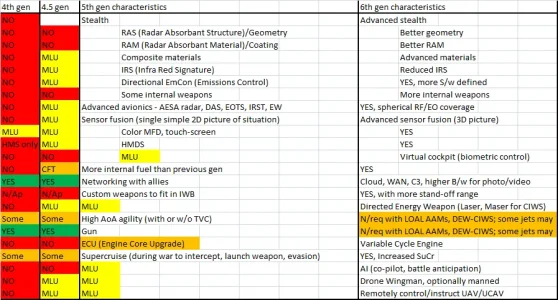
>An empty 5th gen jet also added weight due to permanent inbuilt sensors, EW antennas, fuel tanks, OBOGS, HXs, decoys, etc.
>An empty 6th gen jet also adds more weight due to inbuilt DEW, more computing, C3 system, variable-cycle engine, longer range missiles, stronger EW, etc.
>Increased stealth also demands sufficient weapons carried internally, higher stand-off launch range, bigger NEZ, higher Pk.
>The NAVY jets are not going to face obsolete SAMs, AAMs, radars. Huge anti-surface weapons cannot fit internally. New gen compact weapons with folding fins are needed which can may not sink a surface vessel but immobilize or handicap it. Stronger landing gears, bigger folding wings may add 10-20% more weight depending upon airframe design. But a common airframe/fuselage design can save lots of money. The current TEDBF design is overall 4.5 gen with some components of 5th gen as per present day technologies, but if a next gen follow-on can be made by 2040s then it would be great. So a N-AHCA will be TEDBF 2.0 supplemented by current design.
>At present people say that NAL, ADA, DRDO don't have enough professionals to handle more than AMCA, LCA, MWF, TEDBF & upgrades of current jets.
>All above points puts pressure on Bharat to develop 5.5gen jet at least with adequate weapons, fuel, in a cost effective way.
>Whether funds are cleared for GTRE or JV or import, engines are need for AMCA, MWF, TEDBF & a future advanced heavy jet.
>ISRO has progressed well. If they can contribute anything like for Variable Cycle Engine, materials, compacting avionics, etc something which ADA, NAL, DRDO would take much more time, then IMO it should be considered.
Since days of T-10 prototype & other jets like MiG-25, F-15, our scientists & engineers might have at least discussed if some day they could also make such a home grown jet. And now IMO the R&D should proceed with whatever we have & can avail bcoz reaching Western quality levels will take decades.
I'm using edited cross-section of F-22, a jet flying well, rather than imaginery 6gen models.
CAUTION - The notional depiction doesn't mean all indicated weapons to be carried internally at once. Otherwise it will become a bomber. But a future customized fighter will need future customized weapons & multiple IWBs (Internal Weapons Bays).
We will try to examine individual aspects like payload, avionics, sensors, airframe, engines including Naval requirements but in new gen ways.
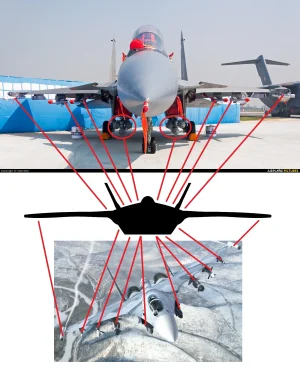
The above picture has been compiled similar to an older one comparing medium weight 1-engine jets of 4.5 generation F-16 & 5th generation F-35.

- This thread is inspired by global tech evolution, R&D & big jets like Su-3X including Naval variant Su-33.
- On casual forum, there is no need to wait for official govt. or DoD statements.
- Neither global tech evolution waits for lagging countries, nor Discussions for every component to mature & be available.
>Some day upgraded Super-Su-30MKI will need replacement by similar size & weight jet due to technological advancement, requirement of 5th-6th gen. Even after Super-Sukhoi upgrade which is analogous to Su-35-S, the RCS & IRS will be quite high.
>The radars, SAMs, AAMs have improved a lot. The latest ones are made aiming 5th gen jets.
>The frontline jets have to be latest gen/tech to act like spies & snipers, which can be supplemented by previous gen jets following behind.
>When the engine &/or airframe design are inadequate, a new airframe & new/modified components are required then a gen leap occurs, who's R&D takes time in decades, hence EU dumped 5th gen & moved to 6th gen FCAS & GCAP to catch up with USA. That's the answer to how can we make 6gen w/o 5gen.
>Hence AMCA & similar jets also may not have adequate thrust, volume for payload, fuel & advanced equipments, range/endurance. Otherwise AMCA in stealth config w/o any CCMs should be expected to use 4 BVR-AAMs with 100% Pk & then kill any adversary with gun.
>Bharat's attempt to make AMCA is sluggish like LCA, bcoz we couldn't get good engines, or even average engines, by self/import/JV to experiment with prototypes, but we are fine with using average engines on active duty jets.
>Bharat exited PAKFA/FGFA project with Russia due to lack of ToT of Su-57. Now there are speculations to get some as stopgap measure.
>China has good numbers of J-20, will have more of it, & will have derivatives of J-31/35.
>S.Korea producing KF-21 Boramae has population of 51.7 million & around 100,000 sqKm. KF-21 will most likely improve like X-35 became F-35.
>Sweden with area 450,000+ sqKm has population 10.6 million with history of making good jets. They were studying on their 5gen Flygsystem 2020. Later there were talks to join GCAP or FCAS. They may announce some surprise any day.
>Turkey with area 783,000+ sqKm & population 86.2 million had its 1st flight of Kaan.
>Kaan & J-31 can be offered to Pakistan.
>Pakistan & China might attept to make 1-engine PFX to replace JF-17.
>Su-57's local numbers are less & no export orders. Russian Su-30/33/35 might get replaced by Su-57 but Russia may develop another jet to counter Western 6th gen designs but may not share ToT with us.
>We already know an outline of differences b/w 5th & 6th gen features, some of which can overlap.

>An empty 5th gen jet also added weight due to permanent inbuilt sensors, EW antennas, fuel tanks, OBOGS, HXs, decoys, etc.
>An empty 6th gen jet also adds more weight due to inbuilt DEW, more computing, C3 system, variable-cycle engine, longer range missiles, stronger EW, etc.
>Increased stealth also demands sufficient weapons carried internally, higher stand-off launch range, bigger NEZ, higher Pk.
>The NAVY jets are not going to face obsolete SAMs, AAMs, radars. Huge anti-surface weapons cannot fit internally. New gen compact weapons with folding fins are needed which can may not sink a surface vessel but immobilize or handicap it. Stronger landing gears, bigger folding wings may add 10-20% more weight depending upon airframe design. But a common airframe/fuselage design can save lots of money. The current TEDBF design is overall 4.5 gen with some components of 5th gen as per present day technologies, but if a next gen follow-on can be made by 2040s then it would be great. So a N-AHCA will be TEDBF 2.0 supplemented by current design.
>At present people say that NAL, ADA, DRDO don't have enough professionals to handle more than AMCA, LCA, MWF, TEDBF & upgrades of current jets.
>All above points puts pressure on Bharat to develop 5.5gen jet at least with adequate weapons, fuel, in a cost effective way.
>Whether funds are cleared for GTRE or JV or import, engines are need for AMCA, MWF, TEDBF & a future advanced heavy jet.
>ISRO has progressed well. If they can contribute anything like for Variable Cycle Engine, materials, compacting avionics, etc something which ADA, NAL, DRDO would take much more time, then IMO it should be considered.
Since days of T-10 prototype & other jets like MiG-25, F-15, our scientists & engineers might have at least discussed if some day they could also make such a home grown jet. And now IMO the R&D should proceed with whatever we have & can avail bcoz reaching Western quality levels will take decades.
I'm using edited cross-section of F-22, a jet flying well, rather than imaginery 6gen models.
CAUTION - The notional depiction doesn't mean all indicated weapons to be carried internally at once. Otherwise it will become a bomber. But a future customized fighter will need future customized weapons & multiple IWBs (Internal Weapons Bays).
We will try to examine individual aspects like payload, avionics, sensors, airframe, engines including Naval requirements but in new gen ways.

The above picture has been compiled similar to an older one comparing medium weight 1-engine jets of 4.5 generation F-16 & 5th generation F-35.

Last edited:






